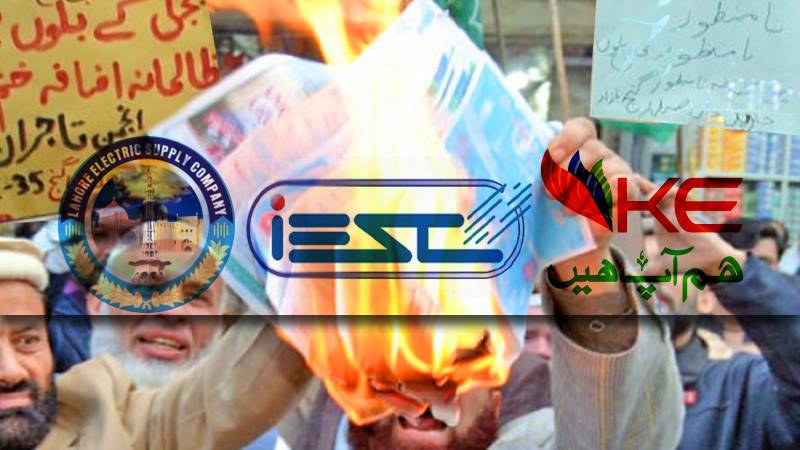
Pakistan is currently grappling with a fresh wave of inflation, driven primarily by the devaluation of the rupee and fluctuations in global commodity prices. This has resulted in a significant reduction in the public's purchasing power.
Adding to mounting concerns, there has been a noticeable surge in electricity bills, which has triggered widespread protests across the country. Frustrated by their diminishing incomes, people are demanding relief and have even advocated for non-payment of the latest month's bills.
Unfortunately, escalating tensions have led to cases of violence against electricity staff attempting to disconnect power connections due to non-payment.
The Caretaker Prime Minister has called for the formulation of a strategy to counter the rising rates and provide assistance. However, a recent meeting has failed to yield any results, as the government grapples with striking a balance between addressing public discontent and adhering to the policy measures agreed upon with the International Monetary Fund (IMF). However, before exploring the available options for the government, it is essential to understand the core of this issue.
The structure & cost
The energy sector in Pakistan comprises of different components that form a complex system. It involves several key players, including energy suppliers, power generation companies (GENCOs & IPPs), and distribution and transmission entities (PEPCOs). Power producers, both private independent power producers (IPPs) and government owned GENCOs, rely on oil refineries and gas companies for fuel. Additionally, WAPDA generates hydroelectricity through water, while K-Electric operates separately using oil and gas.
Once electricity is generated, it is transmitted through the National Transmission & Dispatch Company (NTDC). The responsibility of distributing this energy to end consumers lies with power distributors, namely PEPCOs.
When considering the pricing of the utility, it is important to understand the breakdown of costs. In an article for The News, Economist Ammar Habib highlights five key components: energy costs, capacity charges, transmission and distribution costs, cross-subsidies, and taxation and other government charges.
The contribution to the total bill of each segment is illustrated in the tweet below.
This is what break-up of electricity cost looks like on a per unit basis. Taxes & surcharges make up almost 29% of all tariff. Transmission & Distribution makes up the biggest chunk since its also the most inefficient component. pic.twitter.com/2ITpGc5c1r
— Ammar Khan (@rogueonomist) May 19, 2023
Out of these capacity payments refer to costs that the government incurs as a result of agreements made with Independent Power Producers (IPPs). These agreements entitle the IPPs to receive a minimum payment if the amount of power they generate falls below a certain level due to a lack of demand. In other words, capacity payments ensure that IPPs are compensated for their fixed costs, even if their power generation is not fully utilized.
Consumers are partially feeling the burden of capacity charges of over Rs. 124 billion for the surplus power generation during April-June 2023.
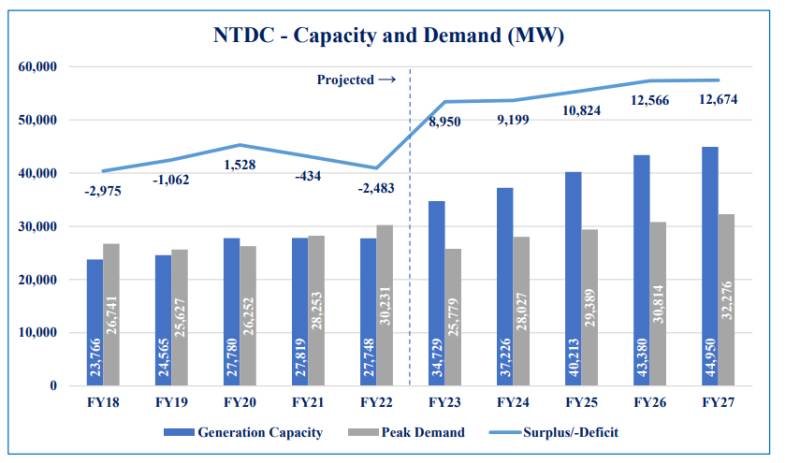
Source: PACRA
As per a Pakistan Credit Rating Agency (PACRA) Report, “Till FY22, there was a 2,483 MW capacity deficit in the NTDC system vs. the peak demand. However, going forward, surplus capacity availability is projected in the system, since demand is expected to grow with a 5-year CAGR of 1.3% while the CAGR for generation capacity is expected at 10.1%.”
Additionally, the distribution charges, which constitute a significant portion of the electricity cost, are also inflated due to outdated transmission infrastructure and electricity theft.
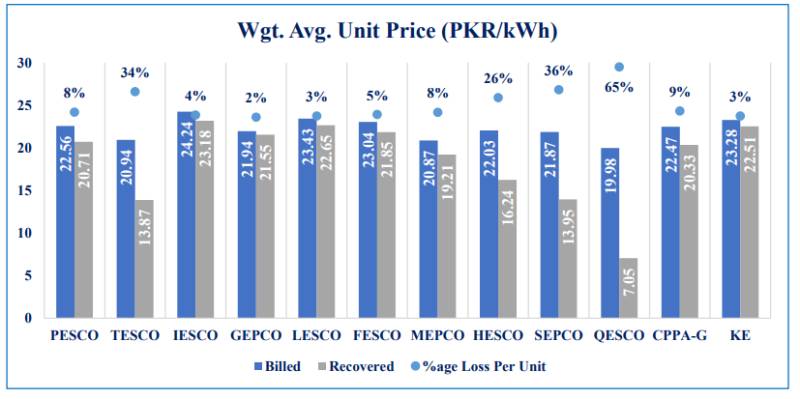
Source: PACRA
Lastly, the component most susceptible to exogenous shocks is the actual energy cost. It is driven by the cost of fuel that is primarily imported. As per a report by Arif Habib Limited (ARHL), “The cost of power generation decreased by 22.1% YoY to PKR 8.34/kWh during July 2023, but still higher than the reference cost of PKR 6.89/kWh. On this basis, there is a projected rise of PKR 2.07/kWh in fuel charge adjustments in the forthcoming months.”
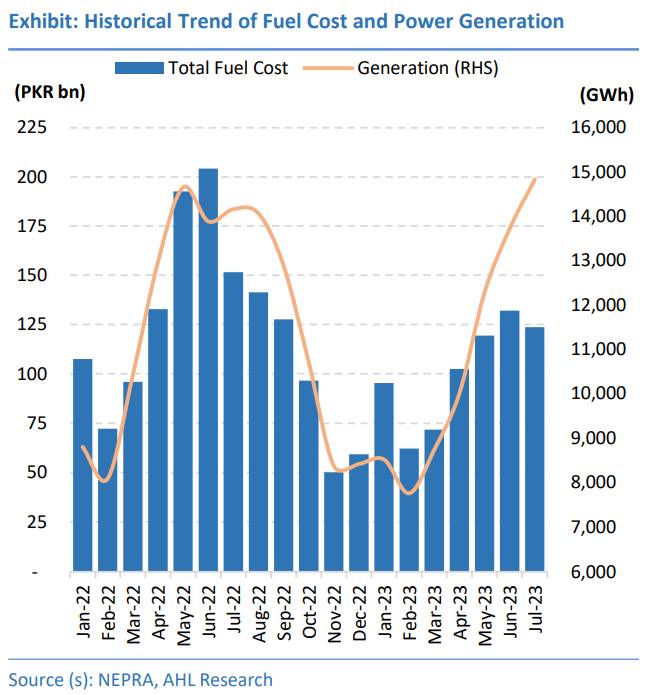
This leads us to Pakistan’s circular debt problem which is a recurring cycle of financial liabilities within the power industry.
As per PACRA, “long standing deficiencies in terms of delayed tariff adjustments, unbudgeted subsidies, weak operational and administrative controls, line losses in excess of ~16% and bill collection losses in excess of 4.6% on distribution network’s part have collectively led to unsustainable levels of circular debt in the power sector.”
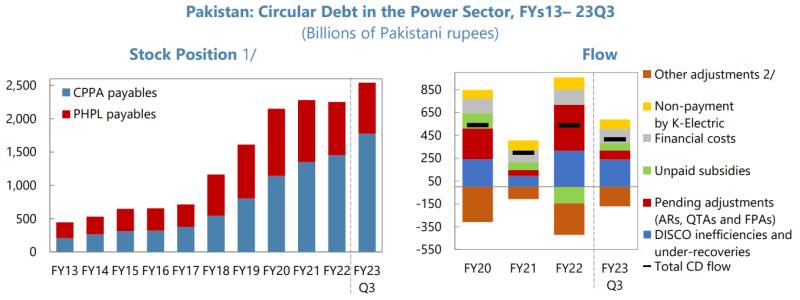
Source: IMF
Therefore, under the terms of the recent Stand by Arrangement (SBA) with the IMF, the government is restricted in its ability to provide relief subsidy to lower the tariffs as it has committed to reduce the circular debt amount and align power tariffs with cost recovery levels.
Options for relief
In the long term, the privatization of distribution companies may improve sectoral efficiencies and lead to cost reductions that can benefit consumers.
While the government is also contemplating a move to hand over the distribution companies to provincial governments in a bid to improve efficiency. “This initiative is in the direction of taking the power sector towards market base reality, which the government has been failing in for the last 25 years. In a way, the electricity distribution companies will not be privatized, and they will not be the responsibility of the federation and will go to the provinces,” remarked business & economics journalist Khurram Husain in an interview.
However, a more suitable short-term measure would be to decrease taxation on electricity and compensate for the resulting fiscal gap through alternative revenue collection methods.
“The taxes that are imposed through electricity bills are distortionary, and inequitable. They hurt the most vulnerable, the poorest households, more than anyone else,” writes economist Ammar Khan in his article for The News.

